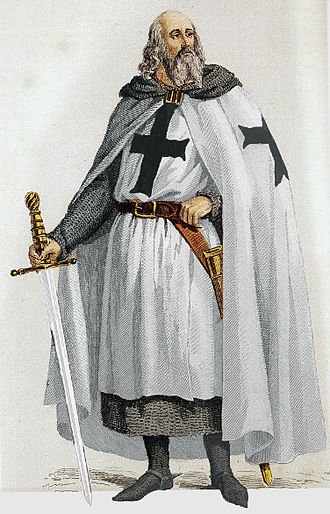1314: Execution of Jacques de Molay
Jacques de Molay, the 23rd and last Grand Master of the Knights Templar, met his tragic end on March 18, 1314, when he was burned at the stake. This event marked the dramatic conclusion of the Templar Order, a wealthy and powerful military group formed during the Crusades.
The Knights Templar, also known as the Poor Fellow-Soldiers of Christ and of the Temple of Solomon, were founded in 1119. They quickly gained prominence and became one of the most influential organizations of their time. The Templars were initially tasked with protecting Christian pilgrims traveling to the Holy Land, but they soon expanded their activities and amassed great wealth and power.
However, their rise to power also attracted the attention and envy of many. King Philip IV of France, in particular, saw an opportunity to eliminate his debts to the Templars and seize their assets. He accused the order of heresy and other crimes, leading to their downfall.
The Accusations and Trials
In 1307, King Philip IV ordered the arrest of all Templars in France. The Templars were accused of various crimes, including idolatry, blasphemy, and engaging in occult practices. These accusations were largely unfounded and were seen as a way for the king to discredit the Templars and justify their persecution.
Jacques de Molay, along with other high-ranking Templar officials, was arrested and put on trial. Despite the lack of evidence, many Templars were tortured and forced to confess to the charges against them. Jacques de Molay himself initially confessed under torture but later recanted his confession, asserting his innocence.
The trials of the Templars were highly controversial, with many questioning the legitimacy of the accusations and the methods used to extract confessions. However, King Philip IV was determined to see the order destroyed, and he pressured Pope Clement V to take action against the Templars.
The Execution
On March 18, 1314, Jacques de Molay and Geoffrey de Charney, another high-ranking Templar, were brought before a crowd in Paris. They were sentenced to death by burning at the stake. According to historical accounts, Jacques de Molay showed great courage and composure during his execution, maintaining his innocence and calling upon both the Pope and the King to answer for their actions.
The execution of Jacques de Molay marked the end of the Templar Order. The Templars’ assets were seized by the French crown, and many of their members were imprisoned or executed. The Templars’ legacy, however, did not end with their destruction.
The Templar Legacy
The Templars left behind a lasting legacy that continues to capture the imagination of people to this day. Their wealth and influence, as well as the mystery surrounding their downfall, have given rise to numerous legends and conspiracy theories.
One of the most enduring myths is that the Templars possessed secret knowledge or relics, such as the Holy Grail or the Ark of the Covenant. These legends have inspired countless books, movies, and treasure hunts, but there is little evidence to support these claims.
Despite the controversy surrounding their demise, the Templars are remembered as skilled warriors and shrewd businessmen. Their banking system, which included the issuance of letters of credit, laid the foundation for modern banking practices.
The story of Jacques de Molay and the Templars serves as a reminder of the dangers of unchecked power and the vulnerability of even the most influential organizations. It is a cautionary tale that continues to resonate with people today.
To learn more about the Templars and their history, you can refer to the following external references:
- Encyclopedia Britannica – Knights Templar
- History.com – The Knights Templar
- National Geographic – The Knights Templar

